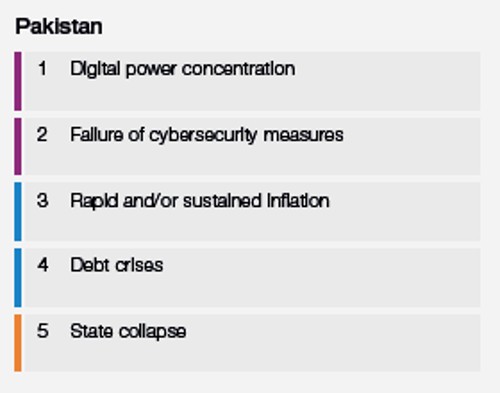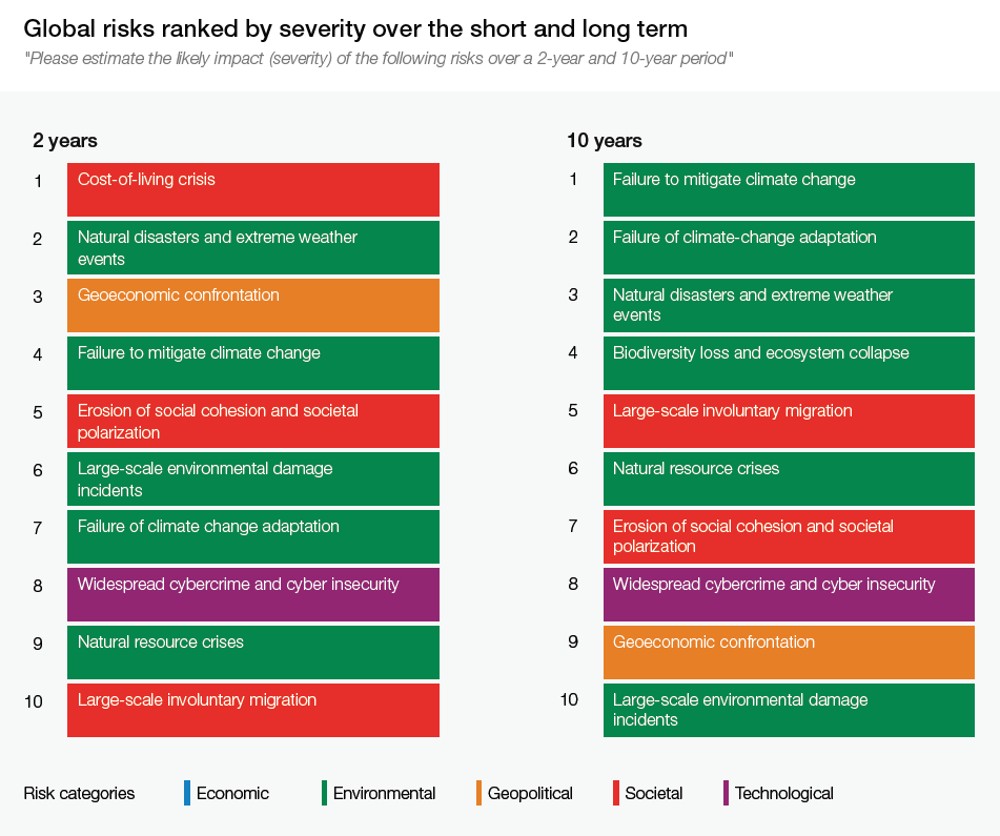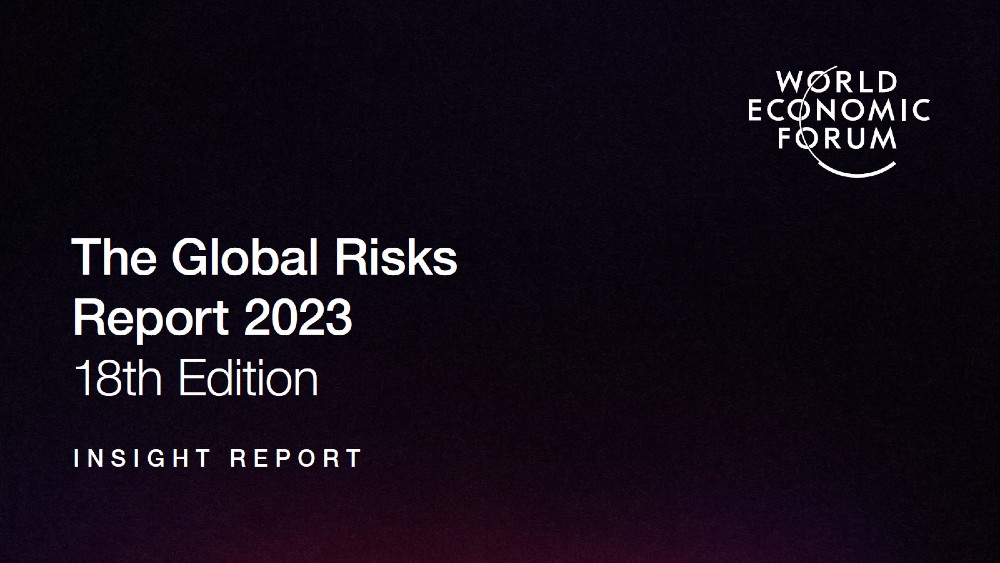While today’s low-growth, high-inflation economy is a worldwide phenomenon, less affluent countries with high-levels of public debt are especially vulnerable to its many hazards, says the WEF’s Global Risks Report 2023.
By Staff Reporter.
ISLAMABAD: Rapid and sustained inflation, debt crises, and state collapse, are three of the top five risks most likely to pose the biggest threat to Pakistan in the next two years according to the findings of an opinion survey conducted by the World Economic Forum (WEF).
The other two to make the list of top five risks likely facing Pakistan over the two-year horizon of the survey are linked with ICTs: digital power concentration. and failure of cybersecurity measures.
Administered between April and September 2022 and covering 121 economies, the Executive Opinion Survey (EOS): National Risk Perceptions asked its respondents the single question: “Which five risks are the most likely to pose the biggest threat to your country in the next two years?”
The more than 12,000 respondents of the 2022 EOS – including private sector executives, top government officials, academics, and senior members of NGO and international organisations – were asked to select these from a list of 35 risks drawn up by the WEF staff, although it is not known how many of them were from Pakistan.
The EOS is an add-on survey to the WEF’s annual GRPS (Global Risks Perception Survey), the findings of which form the body of the WEF’s Global Risks Report 2023 – the 18th Edition of the report published on at the WEF annual meetings in Davos earlier this week.

The risks listed for the EOS are comparable to those in the GRPS but are applied at a more granular level to reflect the possible short-term and country-level manifestations of global risks.
The Global Risks Report 2023 mentions Pakistan in relation to affordability and availability of basic necessities, material possibility of a global food supply crisis occurring in 2023, water stress, and issues centred on a high level of public indebtedness.
“Both affordability and availability of basic necessities can stoke social and political instability”, says the report touching the cost-of-living crisis and the threats it poses. “Last year, the increase in fuel prices alone led to protests in an estimated 92 countries, some of which resulted in political upheaval and fatalities, alongside strikes and industrial action.
“The impact of insecurity will continue to be felt most acutely in already vulnerable states – including Somalia, Sudan, South Sudan and the Syrian Arab Republic – but may also exacerbate instability in countries facing simultaneous food and debt crises, such as Tunisia, Ghana, Pakistan, Egypt and Lebanon”.
In fact, with the continuation of the war in Ukraine, the lagged effect of a fertilizer price spike last year, and the impact of extreme weather conditions on food production, the report sees “a material possibility of a global food supply crisis occurring in 2023”
It quotes estimates suggesting that over 800,000 hectares of farmland were wiped out by floods in Pakistan, resulting in significant commodity prices increases in a country already grappling with record 27 percent inflation.
The report acknowledges that managing inflation is a worldwide concern, and notes that “Rapid and / or sustained inflation” was also highlighted as a top-five risk over the next two years in 89 of the countries surveyed in the EOS.
“It was ranked as the top threat in a number of G20 countries – including Brazil, South Korea and Mexico – although inflationary pressures have affected both developed and developing economies.
“Inflation rates rose above 80 percent in Argentina and Türkiye, while Zimbabwe, the Bolivarian Republic of Venezuela, Lebanon, the Syrian Arab Republic and Sudan witnessed triple-digit inflation.
“Inflation in the United States of America peaked above 9 percent in June last year and hit record highs in the United Kingdom of Great Britain and the Eurozone in October, at 11.1 percent and 10.6 percent, respectively, forcing interest rates higher and inflicting more pain on emerging economies”.
The report notes that general government gross debt for emerging and developing markets was roughly 65 percent of GDP in 2022 compared with 112 percent of GDP in advanced economies “some developing and emerging markets are feeling the impacts of tightening monetary policy and deteriorating economic conditions first and most acutely”.
It cites as examples Ghana, which recently reached an agreement with the IMF regarding a USD 3 billion bailout; and Zambia, seeking to conclude restructuring of USD 15 billion in external debt early this year.
“A broad-based global recession within the year could temper inflation and cap interest rate rises, but there is a higher risk of balance-of-payments crisis in the short-term, alongside a credit crunch over the mid to longer term”, says the report.
“Emerging market banks also hold a larger proportion of domestic public debt, with the potential for distress to spread to banks, households and pension funds. Larger emerging markets exhibiting a heightened risk of default include Argentina, Egypt, Ghana, Kenya, Tunisia, Pakistan and Türkiye”.
While the cost-of-living crisis now gripping much of the world overshadows the short-term (two-year) outlook of the 2023 edition of the Global Risks Report, its long-term outlook is dominated by risks emanating from global warming and climate change.

Much of the 98-page volume reads like a dystopian novel describing a post-apocalyptical future describing the environmental catastrophe looming large over the world, the costs of failure of act in time and in concert, and next-gen technologies and multi-domain conflicts.
However, the Report concludes on a note of cautious optimism, arguing that preparedness is possible by improving risk identification and foresight, investing in multi-domain, cross-sector risk preparedness, and re-building and strengthening global risk preparedness cooperation.
“As we enter a low-growth, low investment and low-cooperation era, the actions that we take today will dictate our future risk landscape. We must ensure that addressing current crises does not detract from the longer-term view” says the report.
To quote the Swiss-Pakistani author and WEF managing director Saadia Zahidi, who wrote the Report’s preface: “[The Report] highlights the multiple areas where the world is at a critical inflection point. It is a call to action, to collectively prepare for the next crisis the world may face and, in doing so, shape a pathway to a more stable, resilient world.”
Copyright © 2021 Independent Pakistan | All rights reserved




